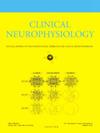Extraction and analysis of abnormal EEG features in children with amblyopia
IF 3.6
3区 医学
Q1 CLINICAL NEUROLOGY
引用次数: 0
Abstract
Objective
Early and accurate diagnosis of amblyopia is crucial for the healthy development of children. Existing clinical diagnostic methods rely on patient cooperation, which can easily lead to misdiagnosis. The commonly used features derived from visual evoked potentials (VEP) only provided limited information for characterizing the whole brain, highlighting the need for integrating additional data sources, such as brain network metrics, to achieve a more comprehensive understanding.
Methods
We extracted 488 features from 64-channel EEG data recorded from thirty amblyopic children. The features mainly derived from a weighted functional brain network based on coherence across different frequency bands. Feature selection and linear classification techniques were employed to assess their effectiveness in distinguishing amblyopia from normal children.
Results
Abnormal EEG features were distributed not only in the occipital lobe but also in non-visual regions, with a higher prevalence in the alpha and beta bands. Their decoding performance surpassed traditional VEP features, and their combination achieved the highest accuracy (89.00%). Moreover, features beyond the occipital lobe exhibited limited decoding performance when considered individually, yet they still have an obvious contribution.
Conclusions
The study identified novel abnormal EEG features associated with amblyopia and demonstrated the potential of multi-channel EEG recordings to assist in the diagnosis of amblyopia.
Significance
The study suggests amblyopia may impair more abilities beyond visual cognition and further provides objective biomarkers for diagnosing amblyopia, which is essential for effective treatment.
弱视儿童异常脑电图特征的提取与分析
目的弱视的早期准确诊断对儿童的健康发展至关重要。现有的临床诊断方法依赖于患者的配合,容易导致误诊。来自视觉诱发电位(VEP)的常用特征仅为描述整个大脑提供了有限的信息,强调需要整合其他数据源,如大脑网络指标,以实现更全面的理解。方法从30例弱视儿童的64通道脑电图数据中提取488个特征。这些特征主要来源于基于不同频段相干性的加权功能脑网络。采用特征选择和线性分类技术评估其在区分弱视和正常儿童中的有效性。结果异常脑电图特征不仅分布于枕叶,也分布于非视觉区,以α和β带发生率较高。它们的解码性能超过了传统的VEP特征,它们的组合达到了最高的准确率(89.00%)。此外,单独考虑枕叶以外的特征时,解码性能有限,但它们仍然有明显的贡献。结论本研究发现了与弱视相关的新的异常脑电图特征,并证明了多通道脑电图记录有助于弱视的诊断。意义本研究提示弱视可能损害视觉认知以外的其他能力,为弱视的诊断提供客观的生物标志物,为有效治疗弱视提供依据。
本文章由计算机程序翻译,如有差异,请以英文原文为准。
求助全文
约1分钟内获得全文
求助全文
来源期刊

Clinical Neurophysiology
医学-临床神经学
CiteScore
8.70
自引率
6.40%
发文量
932
审稿时长
59 days
期刊介绍:
As of January 1999, The journal Electroencephalography and Clinical Neurophysiology, and its two sections Electromyography and Motor Control and Evoked Potentials have amalgamated to become this journal - Clinical Neurophysiology.
Clinical Neurophysiology is the official journal of the International Federation of Clinical Neurophysiology, the Brazilian Society of Clinical Neurophysiology, the Czech Society of Clinical Neurophysiology, the Italian Clinical Neurophysiology Society and the International Society of Intraoperative Neurophysiology.The journal is dedicated to fostering research and disseminating information on all aspects of both normal and abnormal functioning of the nervous system. The key aim of the publication is to disseminate scholarly reports on the pathophysiology underlying diseases of the central and peripheral nervous system of human patients. Clinical trials that use neurophysiological measures to document change are encouraged, as are manuscripts reporting data on integrated neuroimaging of central nervous function including, but not limited to, functional MRI, MEG, EEG, PET and other neuroimaging modalities.
 求助内容:
求助内容: 应助结果提醒方式:
应助结果提醒方式:


